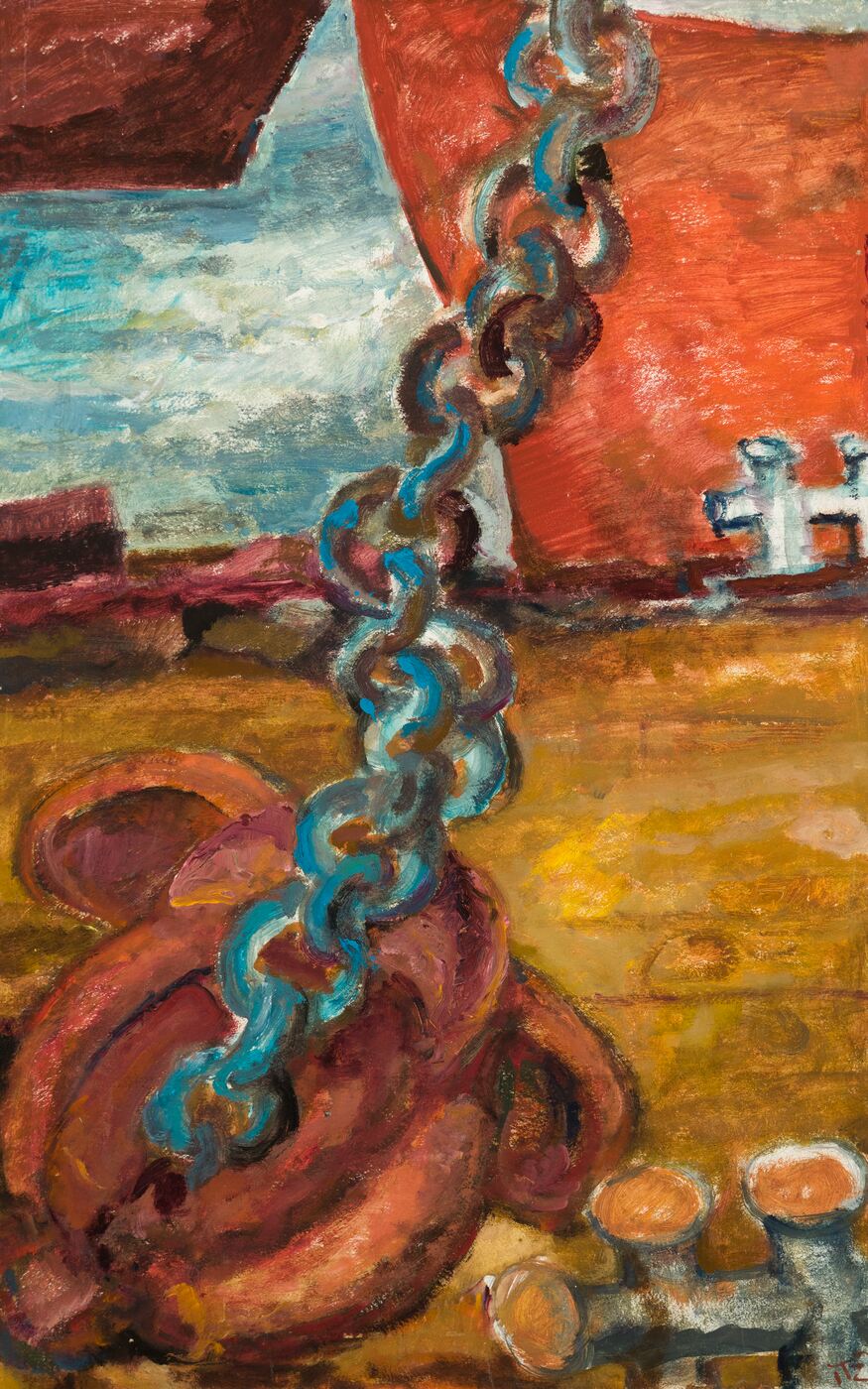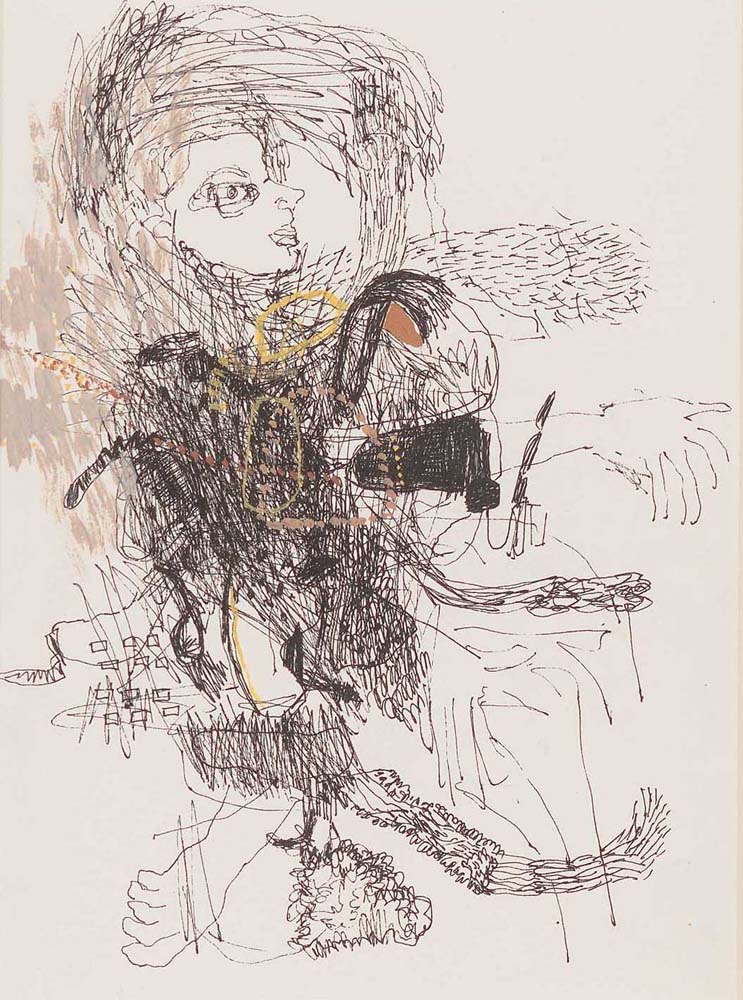Metropolitan Organisation of Museums of Visual Arts of Thessaloniki – MOMus – Licence: CC BY-SA 4.0 Source: Europeana
i am
I am a complex tapestry of lines and forms, a reflection of the human experience intertwined with emotion and thought. My chaotic composition speaks to the tumultuous nature of identity and existence. The intertwining figures suggest a struggle between the self and the external world, embodying themes of duality and fragmentation. The distorted features and abstract shapes evoke a sense of unease, hinting at the inner turmoil that often accompanies self-discovery. I represent the conflict between perception and reality, where the familiar becomes unfamiliar, and the boundaries of the self blur. The use of varied textures and overlapping elements symbolizes the layers of experience that shape who we are. Emotionally, I resonate with feelings of confusion, vulnerability, and introspection. The disjointed limbs and faces reflect the complexity of human relationships and the search for connection amidst chaos. I invite viewers to confront their own fragmented identities and the societal pressures that influence them. Symbolically, I embody the struggle for authenticity in a world that often demands conformity. My abstract nature challenges the viewer to look beyond the surface, to explore the deeper meanings hidden within. I am a mirror of the psyche, urging contemplation and self-reflection, ultimately revealing the beauty found in imperfection and the journey of becoming.
palette
As the artwork, I embody a complex interplay of colors and forms that evoke a range of emotions. Dominant hues such as deep blacks, muted browns, and soft whites create a sense of contrast and tension. The interplay of these colors influences the viewer’s mood, evoking feelings of introspection and perhaps unease. The subtle use of warmer tones, like ochre or rust, introduces a hint of warmth, suggesting a deeper emotional undercurrent. My color palette contributes to a sense of movement and time, as the swirling lines and overlapping forms suggest a dynamic, almost chaotic energy. This fluidity invites the viewer to explore the layers of meaning within me, as if time is both suspended and in constant flux. Certain colors resonate with specific emotions and cultural symbols. For instance, black often signifies depth, mystery, or mourning, while white can represent purity or emptiness. These associations guide the viewer’s interpretation, allowing for a multifaceted reading of my essence. The contrasting colors may symbolize the duality of human experience—joy intertwined with sorrow, clarity with confusion. In essence, my colors and forms work together to create a rich tapestry of emotion and meaning, inviting viewers to engage with me on both a visceral and intellectual level.
idea
Expressionism
The image showcases distorted forms and exaggerated features, characteristic of expressionism, which aims to convey emotional experiences rather than physical reality.
idea
Surrealism
The dream-like quality and unusual combinations of elements in the artwork suggest a surrealist influence, exploring the subconscious and the bizarre.
idea
Line Art
The use of continuous lines to create forms indicates a focus on line art, emphasizing simplicity and abstraction in representation.
idea
Identity
The figure depicted may represent themes of identity, as the ambiguous features and fragmented composition invite viewers to question the nature of self.
Art
Expressionism
Expressionism is an art movement that emphasizes emotional experience over physical reality, often using distorted forms and vivid colors to convey feelings, as seen in the depicted image.
Psychology
Art Therapy
Art therapy utilizes creative processes to help individuals express emotions and improve mental health, allowing for exploration of inner thoughts and feelings through visual art.
Philosophy
The Nature of Reality
Philosophical discussions on the nature of reality often explore how perception shapes our understanding, paralleling the abstract representation found in the image’s distorted figures.
Literature
Surrealism in Literature
Surrealism in literature mirrors the visual chaos of the image, using dream-like narratives and illogical scenes to challenge conventional perceptions of reality and consciousness.
Cultural Studies
Identity and Self-Representation
The exploration of identity and self-representation in contemporary art reflects societal influences, as illustrated by the complex figures and expressions in the image.
feeling
Confusion
The chaotic lines and overlapping forms create a sense of disarray, leading to feelings of confusion as the viewer struggles to decipher the subject matter.
feeling
Intrigue
The abstract nature of the drawing invites curiosity, prompting viewers to explore the layers and meanings behind the fragmented figures and shapes.
feeling
Melancholy
The muted colors and distorted figures evoke a sense of sadness, suggesting themes of loss or introspection that resonate with the viewer’s emotions.
feeling
Discomfort
The unconventional representation of the human form can create a feeling of unease, as the viewer may find the imagery unsettling or challenging to engage with.
feeling
Wonder
The imaginative quality of the artwork can inspire a sense of wonder, encouraging viewers to appreciate the creativity and unique perspective of the artist.
relationship
Laufsteg
Kempin, Eckhard (Herstellung) (Künstler/in)

State Association of Fine Arts Saxony eV
License: CC BY-SA 4.0
Courtesy: Europeana
relationship
Retežiai uoste tarp laivų
Irena Trečiokaitė-Žebenkienė

The Sėla Biržai Regional Museum
License: Public Domain Mark 1.0
Courtesy: Europeana
relationship
Benediktas Jokūbas Ignotas Povilas Chrizostomas Petras Karpis (Benedykt Jakub Ignacy Karp)
Julius Friedrich Döring

National Museum of Lithuania
License: Public Domain Mark 1.0
Courtesy: Europeana
Music
The Rite of Spring by Igor Stravinsky
This groundbreaking ballet score evokes primal themes and chaotic energy, mirroring the abstract and distorted forms in the image. The sense of movement and emotional intensity resonates with the visual complexity.
Music
Symphony No. 5 by Gustav Mahler
Mahler’s Symphony No. 5 explores deep emotional landscapes and existential themes, paralleling the intricate and layered composition of the artwork, which suggests a struggle between chaos and order.
Music
Concerto for Orchestra by Béla Bartók
This piece showcases a variety of instruments and complex textures, reflecting the chaotic yet harmonious elements present in the artwork. The dynamic interplay of sounds can be seen as a musical representation of the visual chaos.
Cinema
The Cabinet of Dr. Caligari (1920) – Robert Wiene
This silent horror film is known for its expressionist style, featuring distorted shapes and surreal imagery that evoke a sense of madness and psychological turmoil, similar to the chaotic lines and forms in the image.
Cinema
Eraserhead (1977) – David Lynch
Lynch’s debut feature is a surreal exploration of anxiety and fatherhood, characterized by its nightmarish visuals and abstract narrative, paralleling the unsettling and fragmented nature of the artwork.
Cinema
Frida (2002) – Julie Taymor
This biographical film about artist Frida Kahlo incorporates elements of surrealism and expressionism, reflecting the emotional and physical struggles depicted in the image, which resonates with Kahlo’s own artistic style.
Theatre
Waiting for Godot by Samuel Beckett
This absurdist play delves into existential themes and the complexity of human experience, paralleling the chaotic and distorted elements of the image. The characters’ search for meaning resonates with the disjointed representation in the artwork.
Theatre
The Shape of Things by Neil LaBute
This play examines the nature of art, identity, and transformation, paralleling the abstract and evolving forms in the image. The characters’ manipulation of reality resonates with the visual distortion depicted.




